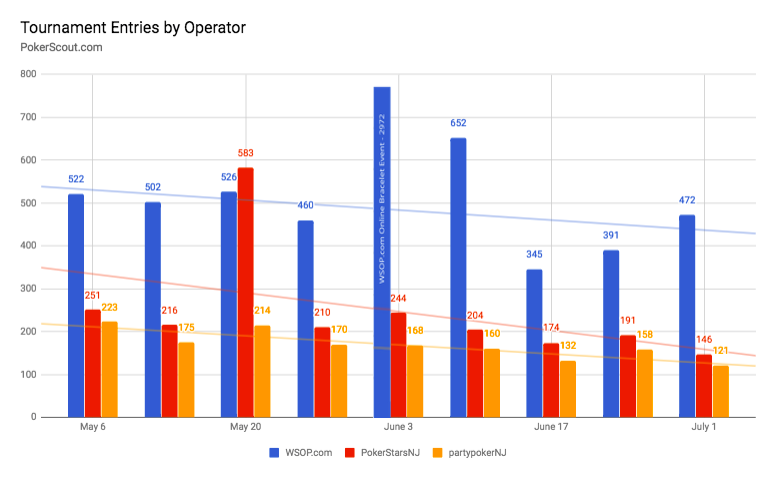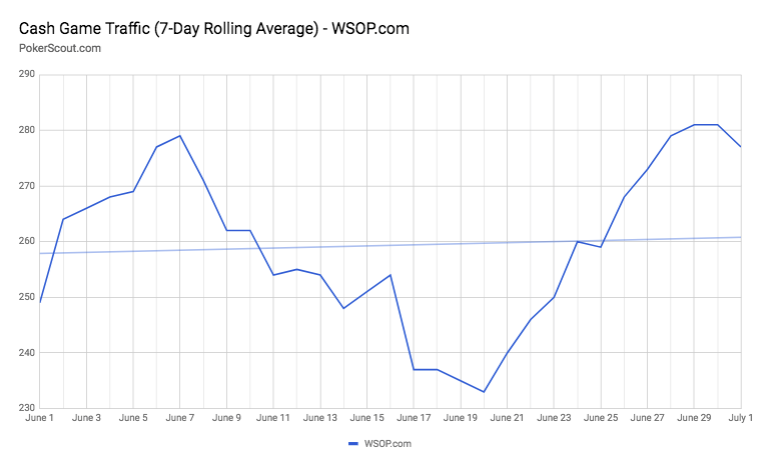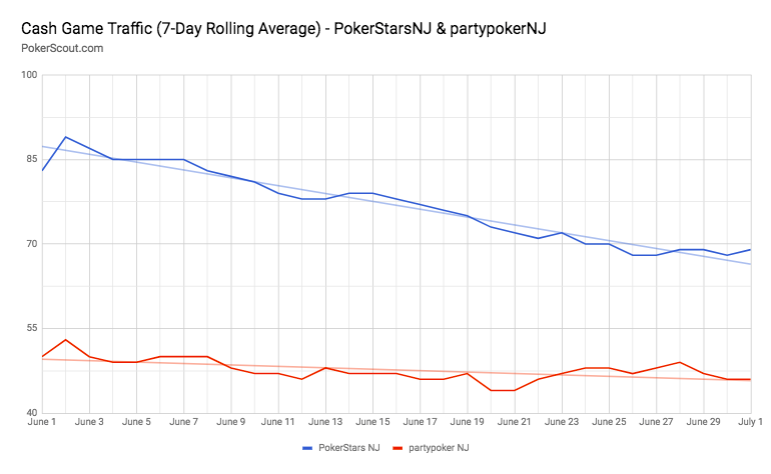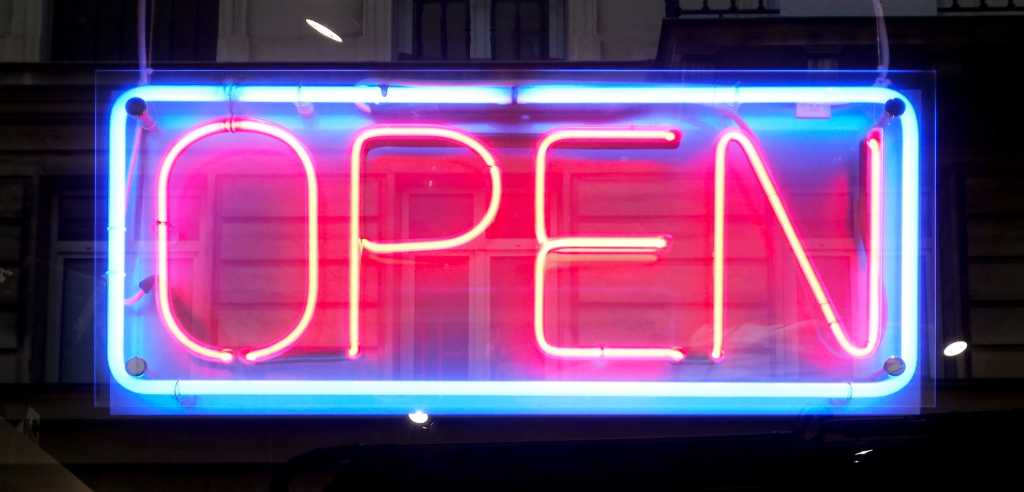Poker players in Nevada, New Jersey, and Delaware are two months into shared liquidity, and the news mixed.
Not surprising, the benefit of WSOP.com being the only operator in Nevada and Delaware is an advantage to the online poker site. Its lead is growing, and it is at the expense of PokerStarsNJ and partypokerNJ.
The key stories since our last report published on June 19:
- Three more gold bracelet events ran on WSOP.com, and the first bracelet went to a player outside of Nevada
- PokerStarsNJ and partypokerNJ lower their Sunday guarantees as tournament entries continue to decline
- The seven-day rolling average for cash game players grows for WSOP.com while declining for PokerStarsNJ and partypokerNJ.
Now, let’s take a look back at the cash game and tournament trends for the two-week period ending July 1, 2018.
U.S. Regulated Online Poker Operators
The major U.S. poker operators are:
Pala Poker also operates in New Jersey on its own network. We do not include Pala Poker in this report because the traffic volume is low and doesn’t affect the latest US online poker trends.
Major online poker tournaments summary
The big tournament news from the last two weeks is golden. Three more online bracelet events took place, and there was more history in the making for WSOP.com.
As expected, the final three online bracelet events did not disappoint with entries, prize pools, and some history-making headlines for WSOP.com.
WSOP.com awards three online bracelets
The first PLO bracelet played out on the virtual felt, and the bracelet went to a New Jersey player while playing in New Jersey.
Event #47: $565 WSOP.com ONLINE Pot-Limit Omaha 6-Handed generated a total of 1,223 total entries. There were 657 unique players and 566 re-entries which created a prize pool of $635,950.
Matthew ‘mendey’ Mendez from Sicklerville, NJ, earned the top prize of $135,077 after battling it out for over 15 hours from his home in New Jersey. He then packed up the family and headed to Las Vegas to collect his first gold bracelet in person.
Event #61: $1,000 WSOP.com ONLINE No-Limit Hold’em Championship registered 1180 unique players. Those players re-entered 455 times for a total 1635 entries.
Ryan ‘Toosick’ Tosoc collected all the chips and took home his share of the $1,553,250 prize pool. It’s the first gold bracelet for Tosoc, and the first-place prize of $238,778 puts Tosoc at over $3.7 million in live earnings.
Event #63: $3,200 WSOP.com ONLINE No-Limit Hold’em High Roller saw a 13% increase in entries over last year with 480. There were 356 players and 124 re-entries that generated a prize pool of $1,459,200.
Chance “BingShui” Kornuth collected his second gold bracelet and the first-place prize of $341,598. It was his sixth cash of the WSOP, and he is nearing $6 million in lifetime earnings.
The expanded online bracelet event schedule was a success. Compared to the technical glitches from the first event, the three events ran rather smoothly.
Of course, there was the occasional player that failed to create a new account on WSOP.com. That was a requirement following the launch of shared liquidity. WSOP.com worked to get players online and playing as fast as they could.
Pennsylvania is likely to be online by the 2019 World Series of Poker. It already indicated it would join the Multi-State Internet Gaming Agreement.
It would not be surprising to see more online bracelet tournaments and more history-making events when poker players convene in the Nevada desert next summer – both in person and virtually.
PokerstarsNJ and partypokerNJ lower their guarantees
The second big tournament poker story from the last two weeks is PokerStarsNJ and partypokerNJ lowered their Sunday major tournament guarantees to $35,000.
It is the second time since the launch of shared liquidity that PokerStarsNJ lowered its guarantee hoping to find the sweet spot. It reduced it for the first time on June 3 and again on June 24. Even so, it barely squeaked by, only exceeding the guarantee by $526.00. On July 1, it was another story as the online poker site posted an overlay of $7,844.
On July 1, partypokerNJ also lowered its guarantee. The site has not met its guarantee for the last six weeks, and the overlays seem to be getting larger. Even after the reduction, it posted a hefty overlay of $10,800. partypokerNJ
Looking at the trend lines for Sunday tournament entries and PokerStarsNJ and the picture isn’t rosy. It is hard to say for sure if this a bonafide trend or if it is a symptom of a big online weekend for WSOP.com.
It will be another few weeks before the WSOP closes down summer camp. The picture is likely to become more clear after that. Overall, the news is not good for the two online poker operators not named WSOP.com.
Major Sunday online poker tournament data
Sunday, June 24, 2018
|
Tournament |
Entries |
Guarantee |
Prize Pool |
Difference |
| WSOP |
$320 Sunday Weekly $100,000 NLH |
394 |
$100,000 |
$173,100.00 |
$73,100.00 |
| PokerStarsNJ |
$200 Sunday Special, $35,000 Guaranteed |
191 |
$35,000 |
$35,526.00 |
$526.00 |
| partypokerNJ |
$215 Sunday $40,000 Guaranteed NLH |
158 |
$40,000.00 |
$31,600.00 |
-$8,400.00 |
Sunday, July 1, 2018
|
Tournament |
Entries |
Guarantee |
Prize Pool |
Difference |
| WSOP |
OC #122 $320 Sunday Weekly $100,000 NLH |
472 |
$100,000.00 |
$141,600.00 |
$41,600.00 |
| PokerStarsNJ |
$200 Sunday Special, $35,000 Guaranteed |
146 |
$35,000 |
27,156 |
-7,844 |
| partypokerNJ |
$215 Sunday $35,000 Guaranteed NLH |
121 |
$35,000 |
24,200 |
-10,800 |

Average cash game and peak traffic summary
The cash game picture isn’t much better than the tournament one, but it’s a bit brighter for WSOP.com than PokerStarsNJ and partypokerNJ.
WSOP.com barely managed a positive trend line last week, but as of July 1 is has a more solid footing.
When we reported last, WSOP.com posted a seven-day rolling average of 260 cash game players. That number was down from 240 for the two-weeks prior. The all-time high was about 280 upon the launch of shared liquidity.
As of July 1, WSOP.com is posting 280 average cash game players on its site. It looks like all that online gold bracelet action helped propel the cash game traffic to some post-liquidity highs giving their rolling average a nice bump.

All that traffic on WSOP.com is taking away from the average cash game traffic on PokerStarsNJ and partypokerNJ. There is no denying that shared liquidity is impacting their traffic even though the declines leveled off a bit over the last week.
As of July 1, PokerStarsNJ has a seven-day rolling average of 70 cash game players, down from its pre-liquidity number of 85. partypokerNJ has 45, down from 50. You can see the more significant drop-off for PokerStars reflected in its trend line.

Peak traffic numbers are reporting similar trend lines to that of the average cash game players. All three online poker sites are trending down.
It is concerning that WSOP.com’s trend line is slightly in negative territory especially during the height of activity on the site.
As mentioned earlier, it is just too hard to tell what this means in an environment that is conflated with online bracelet events, live tournaments, and little to talk about outside of the WSOP.


Factors that will impact U.S. regulated online poker in the coming weeks
WSOP.com’s dominance of the online poker landscape will continue. We will be watching how the market settles down as the World Series of Poker marks the beginning of the end with the Main Event starting this week.
Expect more activity from PokerStarsNJ and partypokerNJ as they start to woo players back to their platforms. It would not be surprising to see healthy promotions or maybe a big tournament series to attract players.
We will be watching the U.S. regulated online poker landscape and reporting back here on July 17.







